Commercial banks financing for micro enterprises: A literature review
Micro enterprises play an important role in the process of economic development of a
country, especially in developing ones. Vietnam is known as an emerging market, with 74% of
the total number of enterprises in the country are micro enterprises. However, the issue of micro
enterprises credit access still remains a confounding problem. The paper focuses on the
characteristics of micro enterprises, the determinants of micro enterprises access to credit,
especially access to commercial banks credit. This question is addressed by reviewing existing
literature and empirical evidence. The results of this analysis indicate the features of Vietnam
micro enterprises and reveal the issue of commercial bank financing for micro enterprises in
Vietnam. ased on the research‟s results some managerial implications are recommended
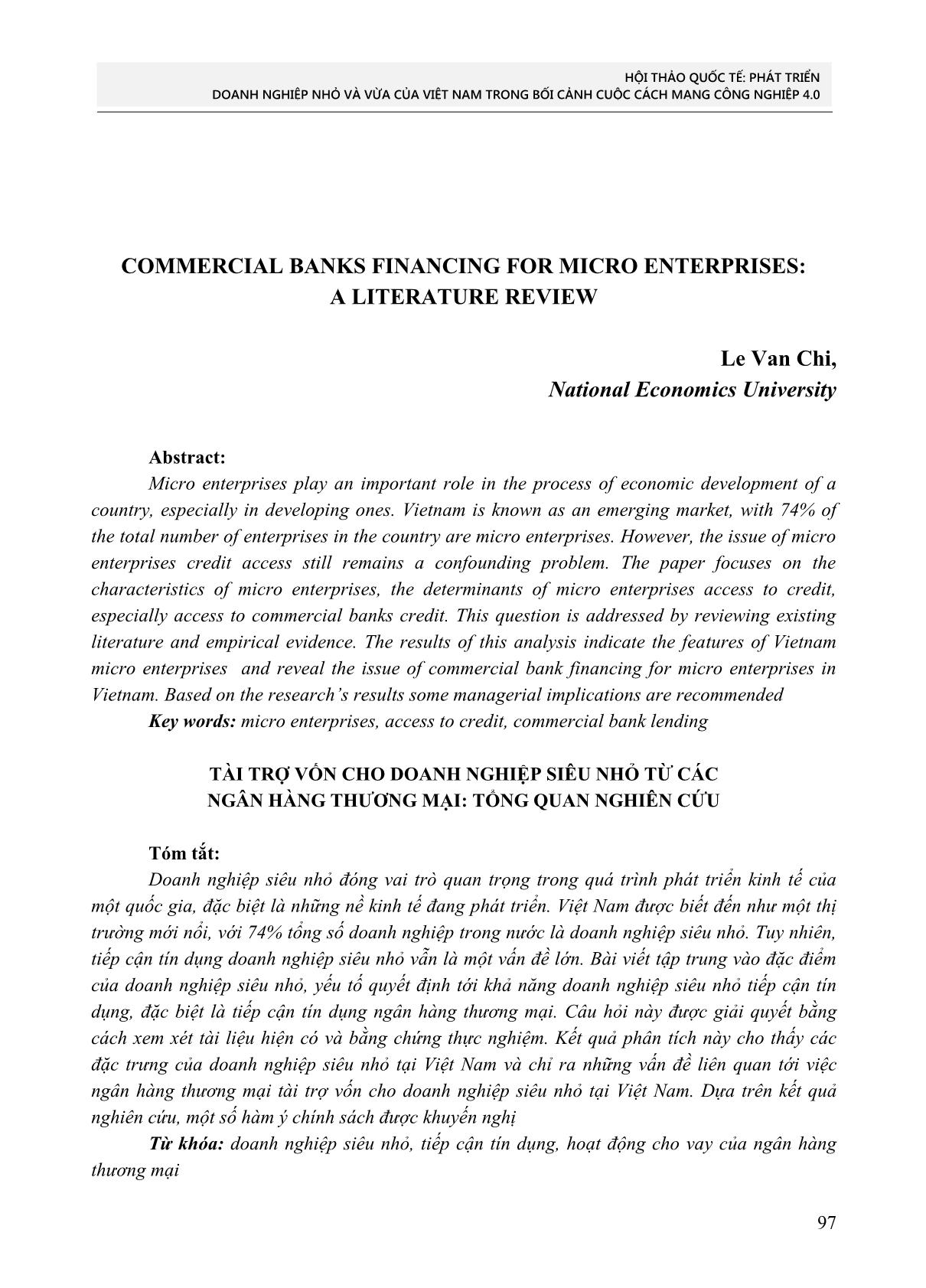
Trang 1
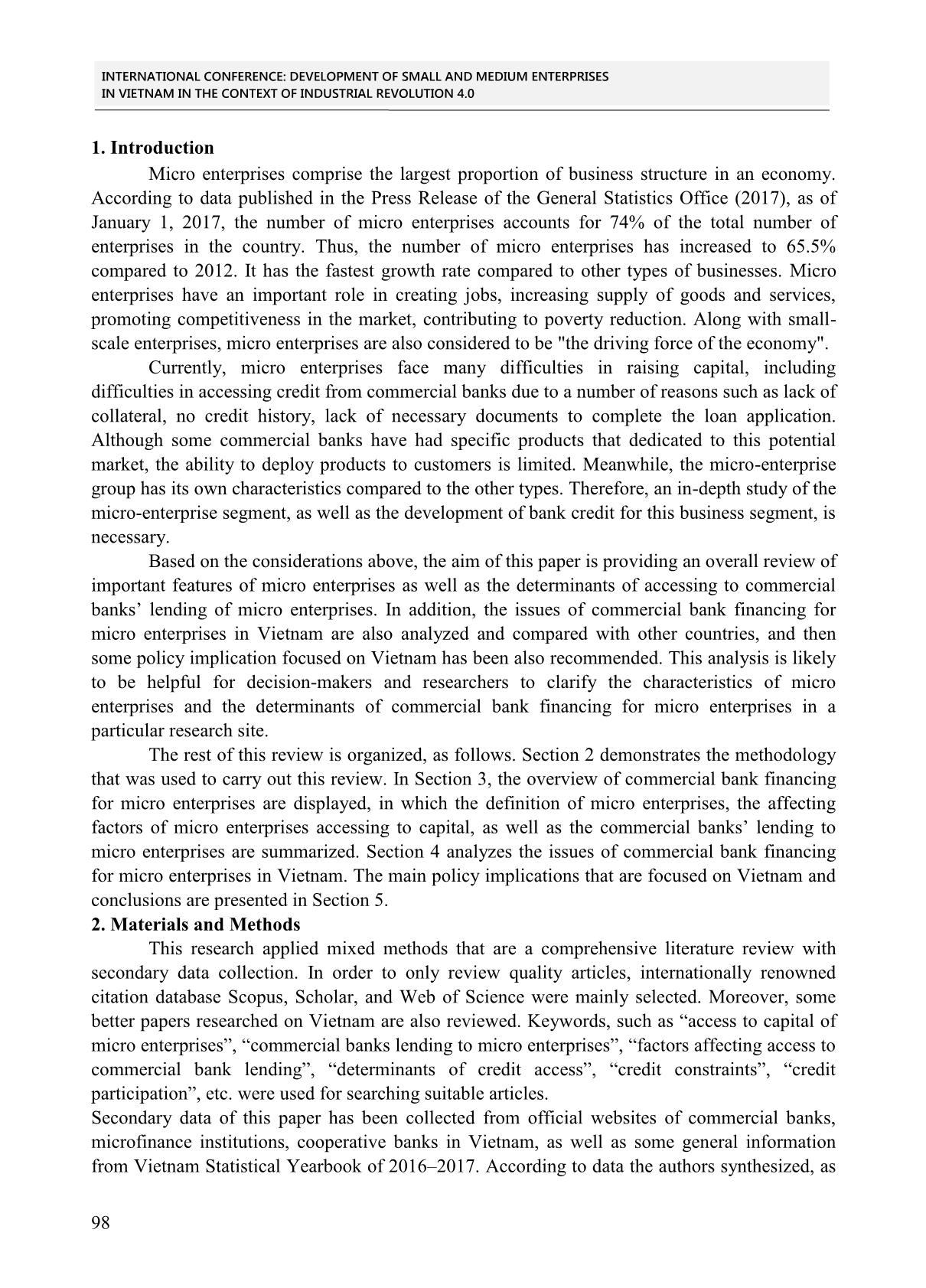
Trang 2
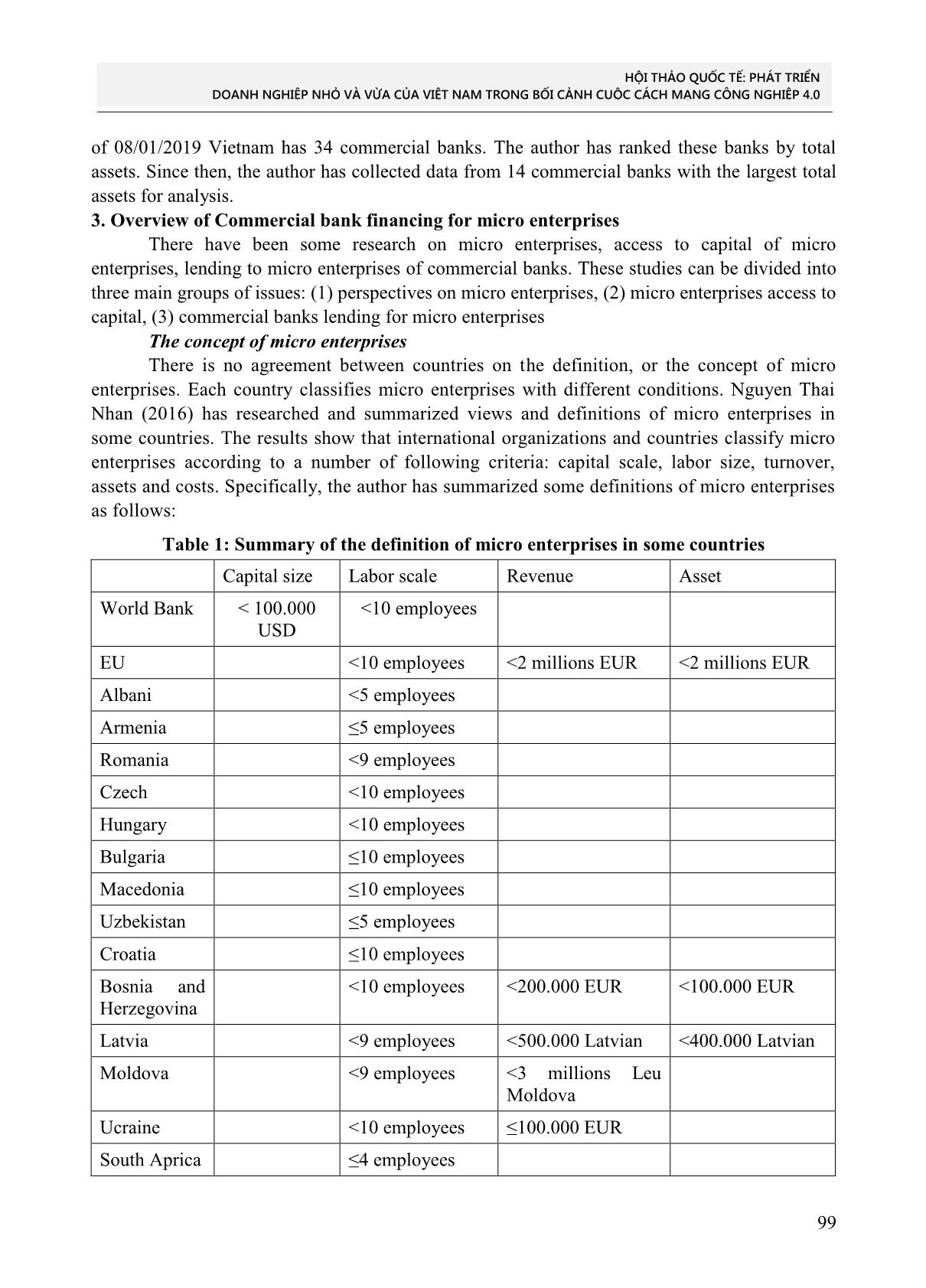
Trang 3
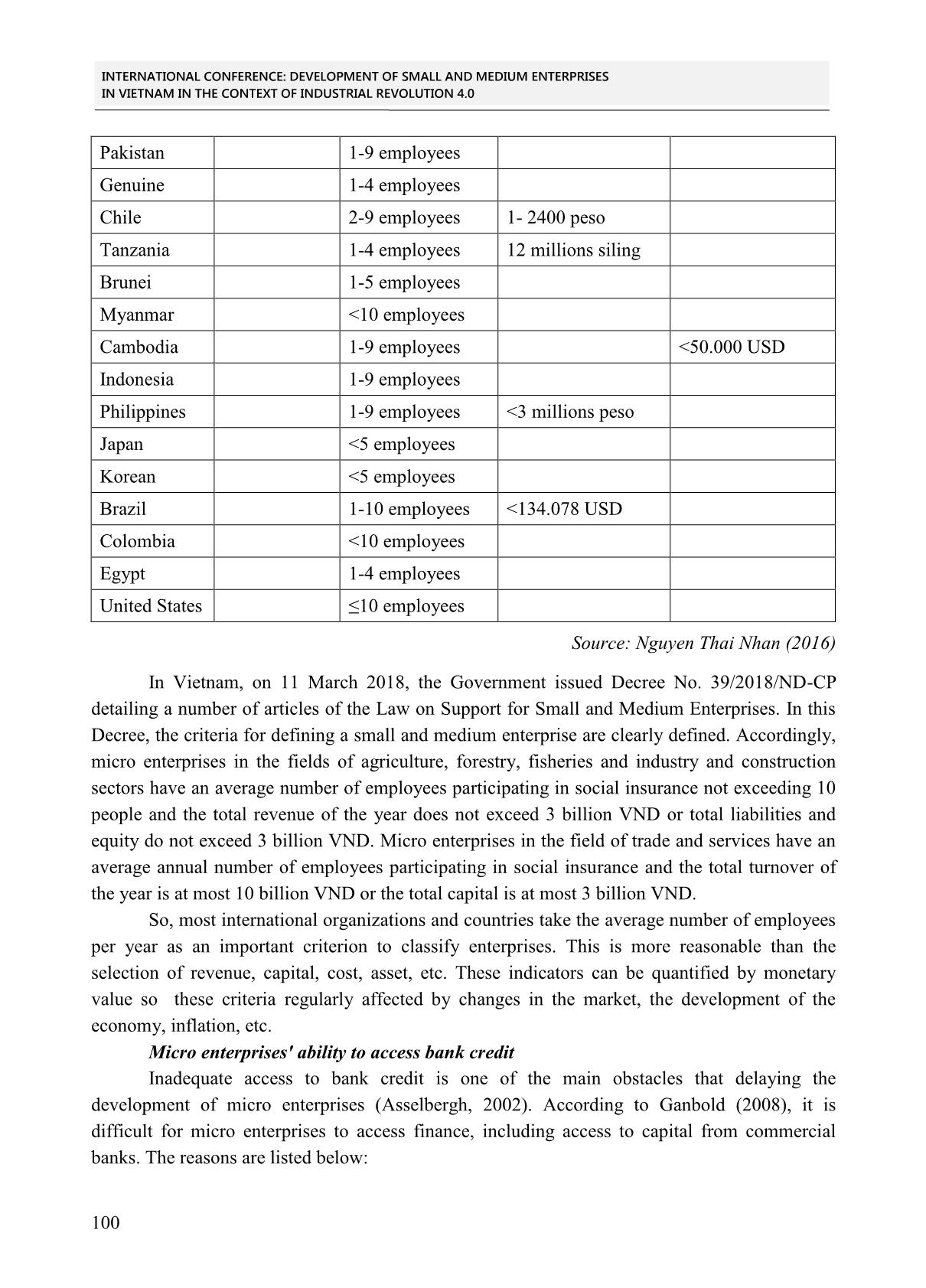
Trang 4
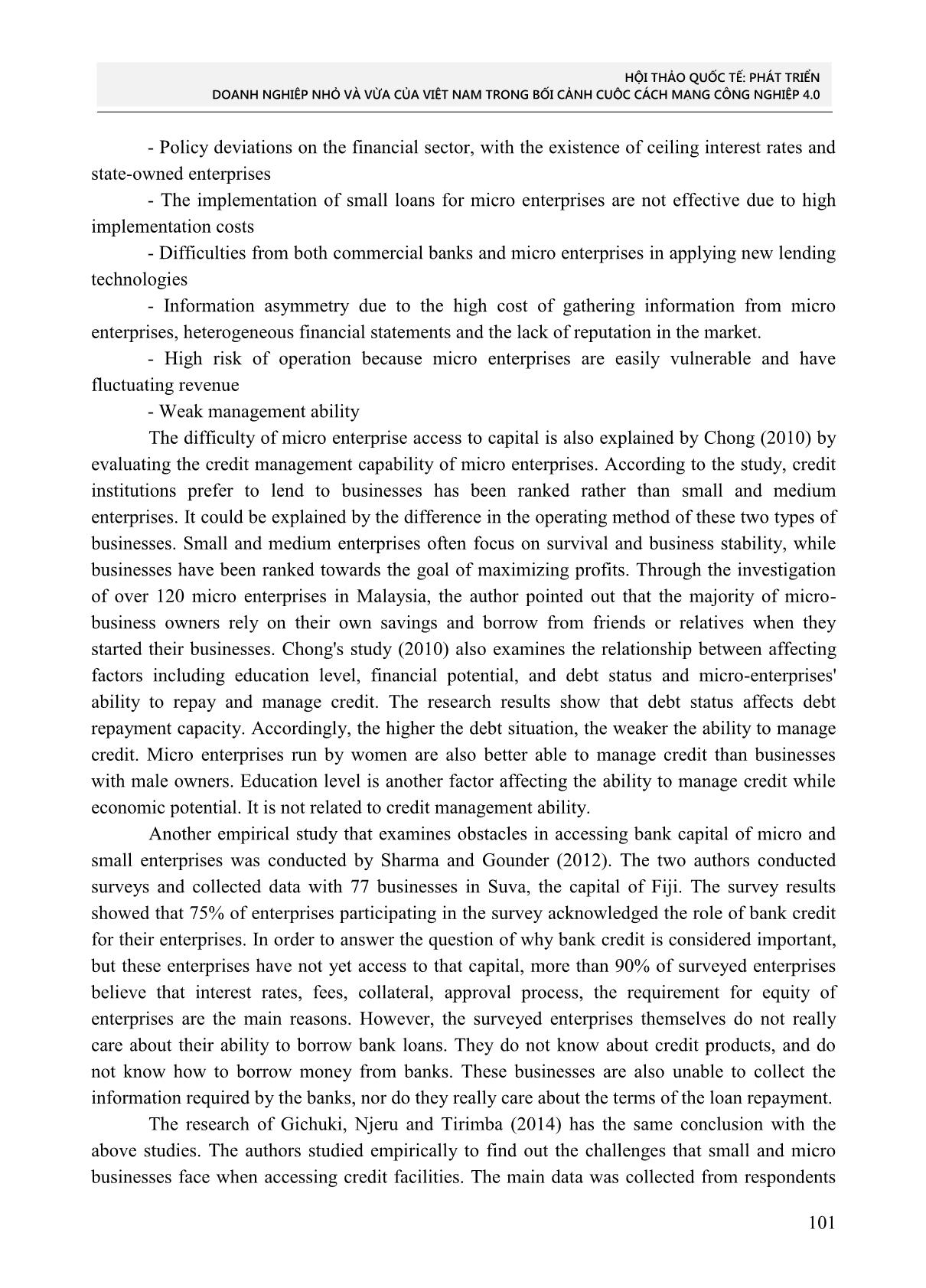
Trang 5
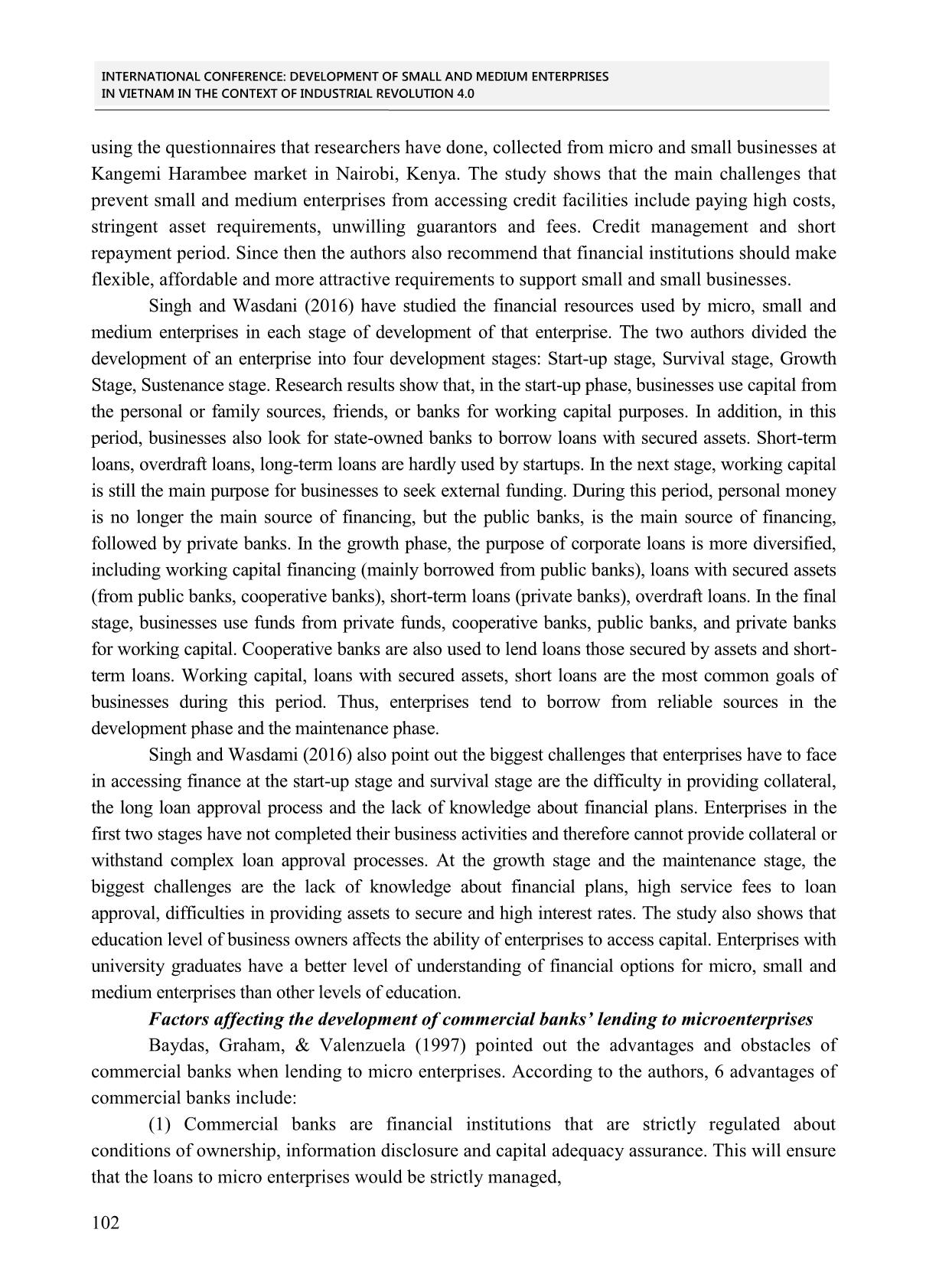
Trang 6
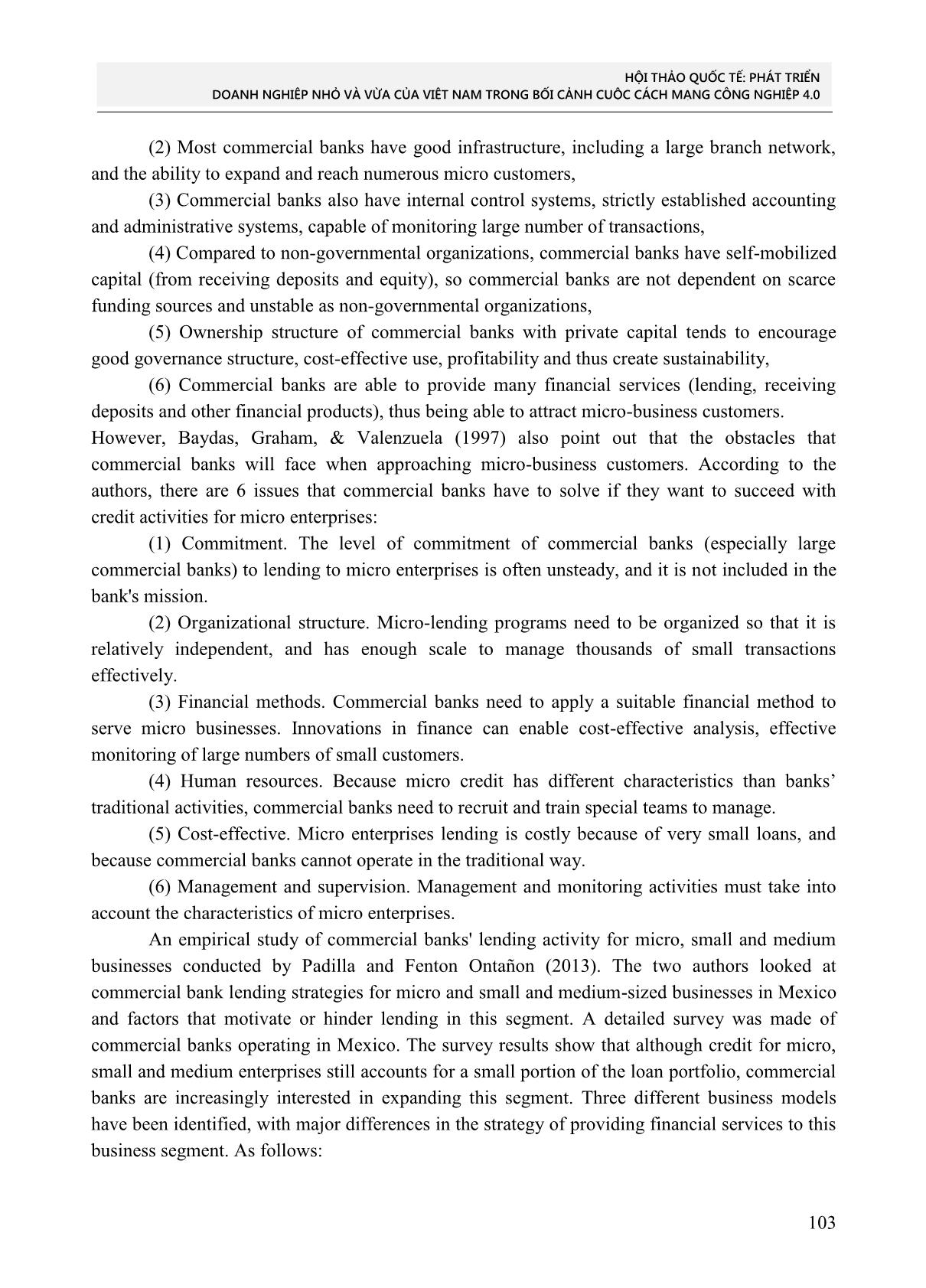
Trang 7
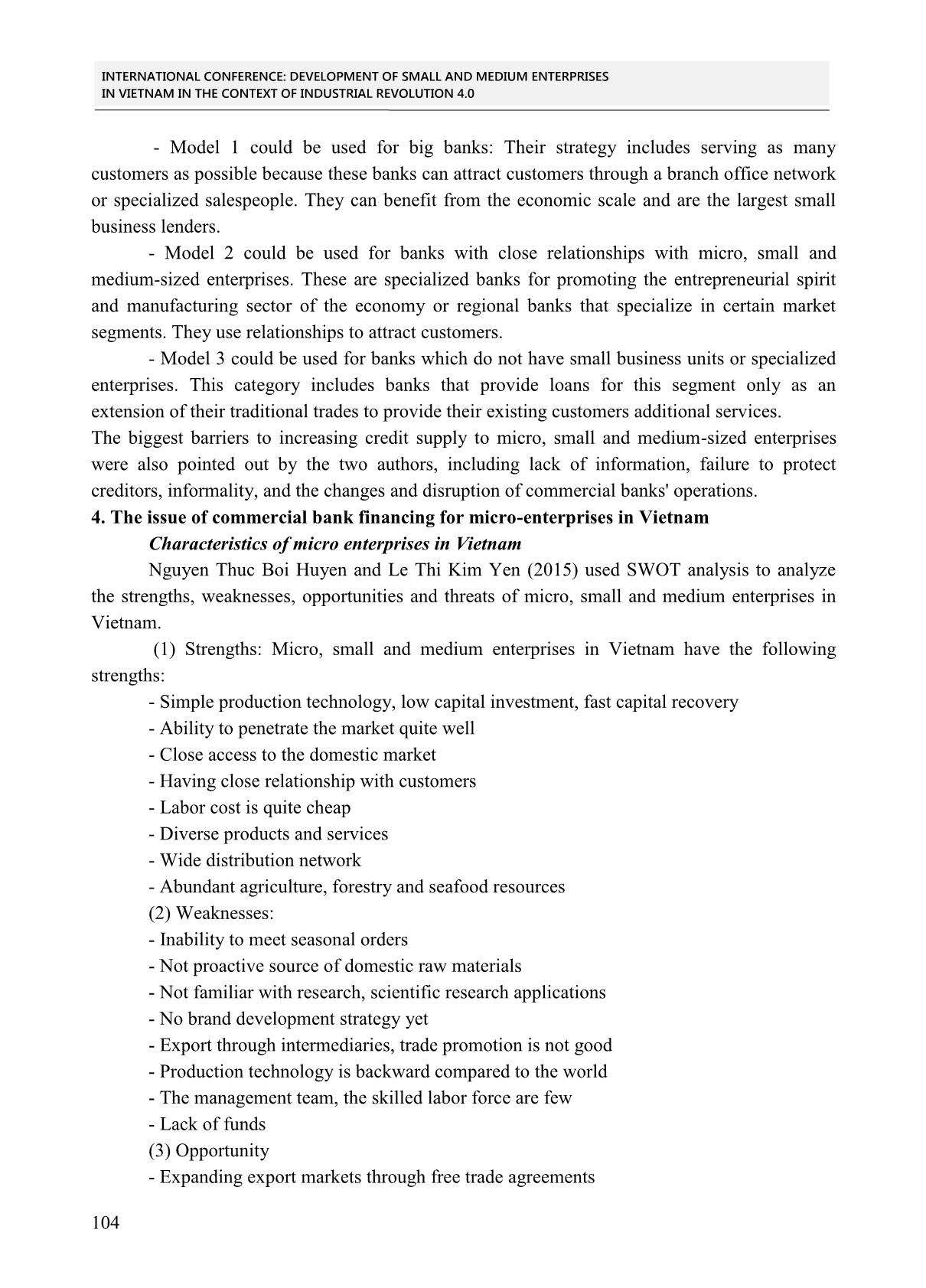
Trang 8
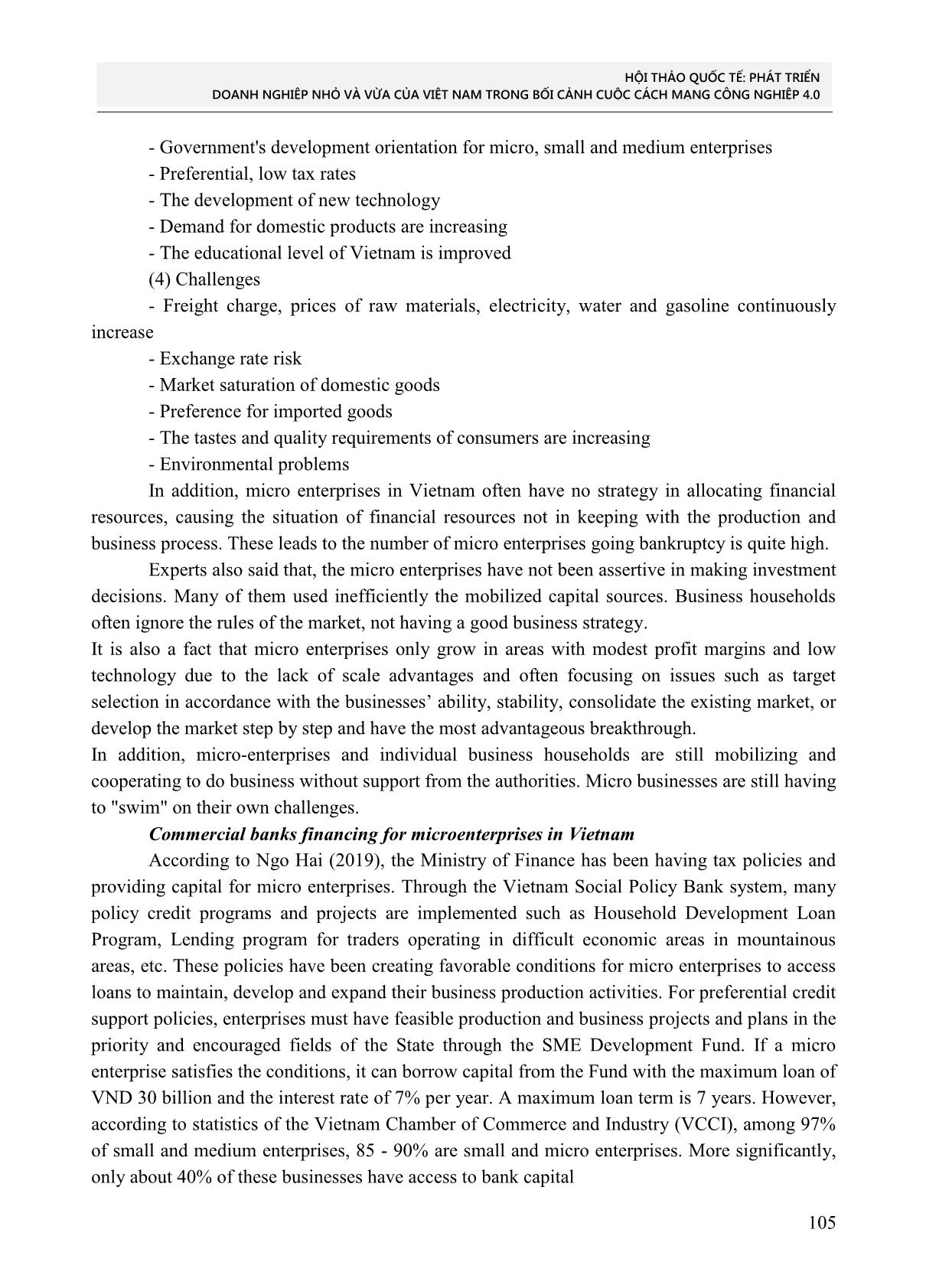
Trang 9
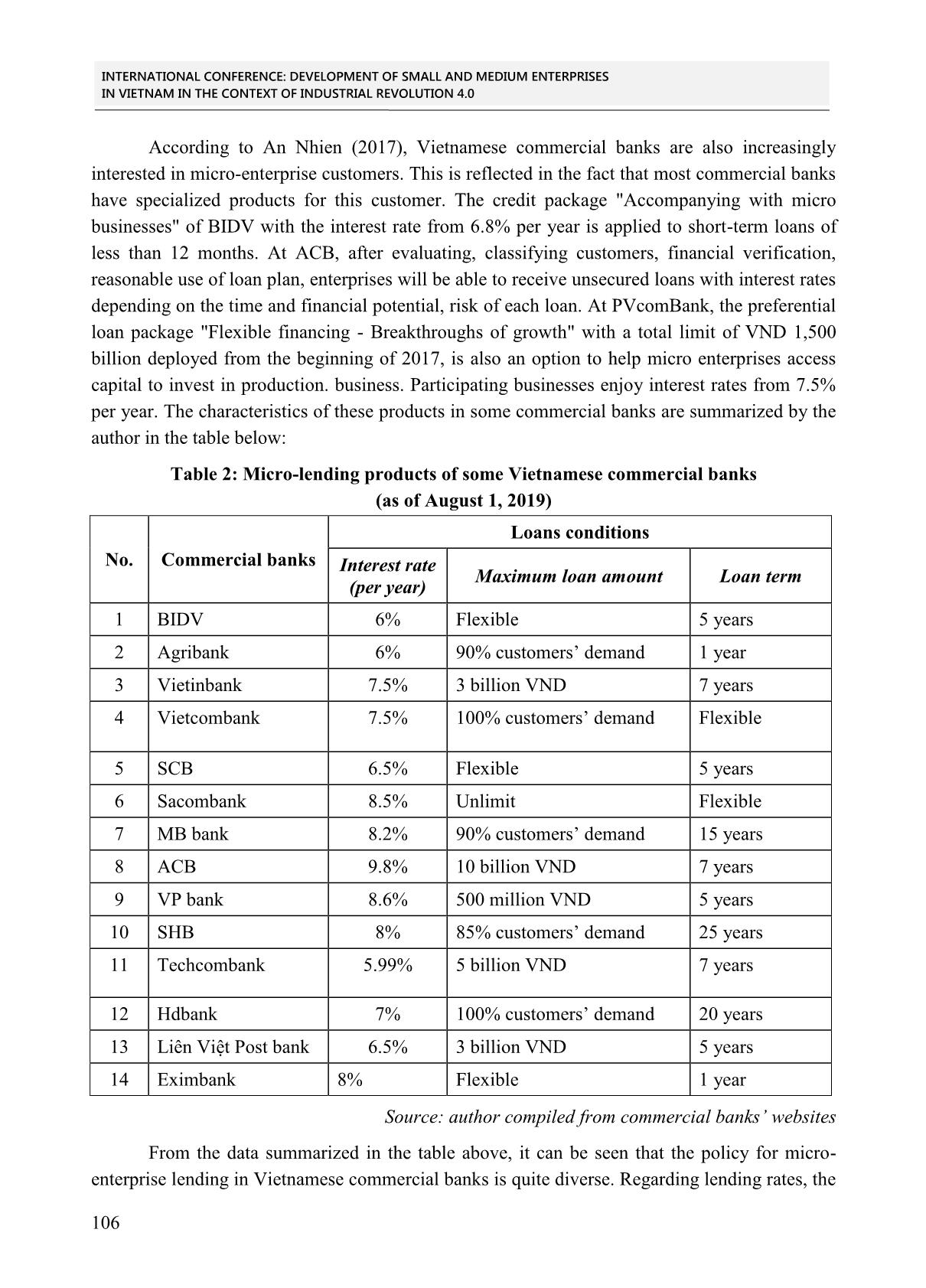
Trang 10
Tải về để xem bản đầy đủ
Tóm tắt nội dung tài liệu: Commercial banks financing for micro enterprises: A literature review
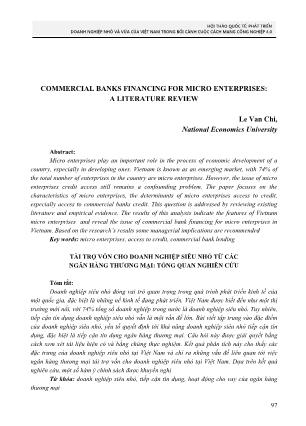
97 HỘI THẢO QUỐC TẾ: PHÁT TRIỂN DOANH NGHIỆP NHỎ VÀ VỪA CỦA VIỆT NAM TRONG BỐI CẢNH CUỘC CÁCH MẠNG CÔNG NGHIỆP 4.0 COMMERCIAL BANKS FINANCING FOR MICRO ENTERPRISES: A LITERATURE REVIEW Le Van Chi, National Economics University Abstract: Micro enterprises play an important role in the process of economic development of a country, especially in developing ones. Vietnam is known as an emerging market, with 74% of the total number of enterprises in the country are micro enterprises. However, the issue of micro enterprises credit access still remains a confounding problem. The paper focuses on the characteristics of micro enterprises, the determinants of micro enterprises access to credit, especially access to commercial banks credit. This question is addressed by reviewing existing literature and empirical evidence. The results of this analysis indicate the features of Vietnam micro enterprises and reveal the issue of commercial bank financing for micro enterprises in Vietnam. ased on the research‟s results some managerial implications are recommended Key words: micro enterprises, access to credit, commercial bank lending TÀI TRỢ VỐN CHO DOANH NGHIỆP SIÊU NHỎ TỪ CÁC NGÂN HÀNG THƢƠNG MẠI: TỔNG QUAN NGHIÊN CỨU Tóm tắt: Doanh nghiệp siêu nhỏ đóng vai trò quan trọng trong quá trình phát triển kinh tế của một quốc gia, đặc biệt là những nề kinh tế đang phát triển. Việt Nam được biết đến như một thị trường mới nổi, với 74% tổng số doanh nghiệp trong nước là doanh nghiệp siêu nhỏ. Tuy nhiên, tiếp cận tín dụng doanh nghiệp siêu nhỏ vẫn là một vấn đề lớn. Bài viết tập trung vào đặc điểm của doanh nghiệp siêu nhỏ, yếu tố quyết định tới khả năng doanh nghiệp siêu nhỏ tiếp cận tín dụng, đặc biệt là tiếp cận tín dụng ngân hàng thương mại. Câu hỏi này được giải quyết bằng cách xem xét tài liệu hiện có và bằng chứng thực nghiệm. Kết quả phân tích này cho thấy các đặc trưng của doanh nghiệp siêu nhỏ tại Việt Nam và ch ra những vấn đề liên quan tới việc ngân hàng thương mại tài trợ vốn cho doanh nghiệp siêu nhỏ tại Việt Nam. Dựa trên kết quả nghiên cứu, một số hàm ý ch nh sách được khuyến nghị Từ khóa: doanh nghiệp siêu nhỏ, tiếp cận tín dụng, hoạt động cho vay của ngân hàng thương mại 98 INTERNATIONAL CONFERENCE: DEVELOPMENT OF SMALL AND MEDIUM ENTERPRISES IN VIETNAM IN THE CONTEXT OF INDUSTRIAL REVOLUTION 4.0 1. Introduction Micro enterprises comprise the largest proportion of business structure in an economy. According to data published in the Press Release of the General Statistics Office (2017), as of January 1, 2017, the number of micro enterprises accounts for 74% of the total number of enterprises in the country. Thus, the number of micro enterprises has increased to 65.5% compared to 2012. It has the fastest growth rate compared to other types of businesses. Micro enterprises have an important role in creating jobs, increasing supply of goods and services, promoting competitiveness in the market, contributing to poverty reduction. Along with small- scale enterprises, micro enterprises are also considered to be "the driving force of the economy". Currently, micro enterprises face many difficulties in raising capital, including difficulties in accessing credit from commercial banks due to a number of reasons such as lack of collateral, no credit history, lack of necessary documents to complete the loan application. Although some commercial banks have had specific products that dedicated to this potential market, the ability to deploy products to customers is limited. Meanwhile, the micro-enterprise group has its own characteristics compared to the other types. Therefore, an in-depth study of the micro-enterprise segment, as well as the development of bank credit for this business segment, is necessary. Based on the considerations above, the aim of this paper is providing an overall review of important features of micro enterprises as well as the determinants of accessing to commercial banks‘ lending of micro enterprises. In addition, the issues of commercial bank financing for micro enterprises in Vietnam are also analyzed and compared with other countries, and then some policy implication focused on Vietnam has been also recommended. This analysis is likely to be helpful for decision-makers and researchers to clarify the characteristics of micro enterprises and the determinants of commercial bank financing for micro enterprises in a particular research site. The rest of this review is organized, as follows. Section 2 demonstrates the methodology that was used to carry out this review. In Section 3, the overview of commercial bank financing for micro enterprises are displayed, in which the definition of micro enterprises, the affecting factors of micro enterprises accessing to capital, as well as the commercial banks‘ lending to micro enterprises are summarized. Section 4 analyzes the issues of commercial bank financing for micro enterprises in Vietnam. The main policy implications that are focused on Vietnam and conclusions are presented in Section 5. 2. Materials and Methods This research applied mixed methods that are a comprehensive literature review with secondary data collection. In order to only review quality articles, internationally renowned citation database Scopus, Scholar, and Web of Science were mainly selected. Moreover, some better papers researched on Vietnam are also reviewed. Keywords, such as ―access to capital of micro enterprises‖, ―commercial banks lending to micro enterprises‖, ―factors affecting access to commercial bank lending‖, ―determinants of credit access‖, ―credit constraints‖, ―credit participation‖, etc. were used for searching suitable articles. Secondary data of this paper has been collected from official websites of commercial banks, microfinance institutions, cooperative banks in Vietnam, as well as some general ... ercial banks' lending activity for micro, small and medium businesses conducted by Padilla and Fenton Ontañon (2013). The two authors looked at commercial bank lending strategies for micro and small and medium-sized businesses in Mexico and factors that motivate or hinder lending in this segment. A detailed survey was made of commercial banks operating in Mexico. The survey results show that although credit for micro, small and medium enterprises still accounts for a small portion of the loan portfolio, commercial banks are increasingly interested in expanding this segment. Three different business models have been identified, with major differences in the strategy of providing financial services to this business segment. As follows: 104 INTERNATIONAL CONFERENCE: DEVELOPMENT OF SMALL AND MEDIUM ENTERPRISES IN VIETNAM IN THE CONTEXT OF INDUSTRIAL REVOLUTION 4.0 - Model 1 could be used for big banks: Their strategy includes serving as many customers as possible because these banks can attract customers through a branch office network or specialized salespeople. They can benefit from the economic scale and are the largest small business lenders. - Model 2 could be used for banks with close relationships with micro, small and medium-sized enterprises. These are specialized banks for promoting the entrepreneurial spirit and manufacturing sector of the economy or regional banks that specialize in certain market segments. They use relationships to attract customers. - Model 3 could be used for banks which do not have small business units or specialized enterprises. This category includes banks that provide loans for this segment only as an extension of their traditional trades to provide their existing customers additional services. The biggest barriers to increasing credit supply to micro, small and medium-sized enterprises were also pointed out by the two authors, including lack of information, failure to protect creditors, informality, and the changes and disruption of commercial banks' operations. 4. The issue of commercial bank financing for micro-enterprises in Vietnam Characteristics of micro enterprises in Vietnam Nguyen Thuc Boi Huyen and Le Thi Kim Yen (2015) used SWOT analysis to analyze the strengths, weaknesses, opportunities and threats of micro, small and medium enterprises in Vietnam. (1) Strengths: Micro, small and medium enterprises in Vietnam have the following strengths: - Simple production technology, low capital investment, fast capital recovery - Ability to penetrate the market quite well - Close access to the domestic market - Having close relationship with customers - Labor cost is quite cheap - Diverse products and services - Wide distribution network - Abundant agriculture, forestry and seafood resources (2) Weaknesses: - Inability to meet seasonal orders - Not proactive source of domestic raw materials - Not familiar with research, scientific research applications - No brand development strategy yet - Export through intermediaries, trade promotion is not good - Production technology is backward compared to the world - The management team, the skilled labor force are few - Lack of funds (3) Opportunity - Expanding export markets through free trade agreements 105 HỘI THẢO QUỐC TẾ: PHÁT TRIỂN DOANH NGHIỆP NHỎ VÀ VỪA CỦA VIỆT NAM TRONG BỐI CẢNH CUỘC CÁCH MẠNG CÔNG NGHIỆP 4.0 - Government's development orientation for micro, small and medium enterprises - Preferential, low tax rates - The development of new technology - Demand for domestic products are increasing - The educational level of Vietnam is improved (4) Challenges - Freight charge, prices of raw materials, electricity, water and gasoline continuously increase - Exchange rate risk - Market saturation of domestic goods - Preference for imported goods - The tastes and quality requirements of consumers are increasing - Environmental problems In addition, micro enterprises in Vietnam often have no strategy in allocating financial resources, causing the situation of financial resources not in keeping with the production and business process. These leads to the number of micro enterprises going bankruptcy is quite high. Experts also said that, the micro enterprises have not been assertive in making investment decisions. Many of them used inefficiently the mobilized capital sources. Business households often ignore the rules of the market, not having a good business strategy. It is also a fact that micro enterprises only grow in areas with modest profit margins and low technology due to the lack of scale advantages and often focusing on issues such as target selection in accordance with the businesses‘ ability, stability, consolidate the existing market, or develop the market step by step and have the most advantageous breakthrough. In addition, micro-enterprises and individual business households are still mobilizing and cooperating to do business without support from the authorities. Micro businesses are still having to "swim" on their own challenges. Commercial banks financing for microenterprises in Vietnam According to Ngo Hai (2019), the Ministry of Finance has been having tax policies and providing capital for micro enterprises. Through the Vietnam Social Policy Bank system, many policy credit programs and projects are implemented such as Household Development Loan Program, Lending program for traders operating in difficult economic areas in mountainous areas, etc. These policies have been creating favorable conditions for micro enterprises to access loans to maintain, develop and expand their business production activities. For preferential credit support policies, enterprises must have feasible production and business projects and plans in the priority and encouraged fields of the State through the SME Development Fund. If a micro enterprise satisfies the conditions, it can borrow capital from the Fund with the maximum loan of VND 30 billion and the interest rate of 7% per year. A maximum loan term is 7 years. However, according to statistics of the Vietnam Chamber of Commerce and Industry (VCCI), among 97% of small and medium enterprises, 85 - 90% are small and micro enterprises. More significantly, only about 40% of these businesses have access to bank capital 106 INTERNATIONAL CONFERENCE: DEVELOPMENT OF SMALL AND MEDIUM ENTERPRISES IN VIETNAM IN THE CONTEXT OF INDUSTRIAL REVOLUTION 4.0 According to An Nhien (2017), Vietnamese commercial banks are also increasingly interested in micro-enterprise customers. This is reflected in the fact that most commercial banks have specialized products for this customer. The credit package "Accompanying with micro businesses" of BIDV with the interest rate from 6.8% per year is applied to short-term loans of less than 12 months. At ACB, after evaluating, classifying customers, financial verification, reasonable use of loan plan, enterprises will be able to receive unsecured loans with interest rates depending on the time and financial potential, risk of each loan. At PVcomBank, the preferential loan package "Flexible financing - Breakthroughs of growth" with a total limit of VND 1,500 billion deployed from the beginning of 2017, is also an option to help micro enterprises access capital to invest in production. business. Participating businesses enjoy interest rates from 7.5% per year. The characteristics of these products in some commercial banks are summarized by the author in the table below: Table 2: Micro-lending products of some Vietnamese commercial banks (as of August 1, 2019) No. Commercial banks Loans conditions Interest rate (per year) Maximum loan amount Loan term 1 BIDV 6% Flexible 5 years 2 Agribank 6% 90% customers‘ demand 1 year 3 Vietinbank 7.5% 3 billion VND 7 years 4 Vietcombank 7.5% 100% customers‘ demand Flexible 5 SCB 6.5% Flexible 5 years 6 Sacombank 8.5% Unlimit Flexible 7 MB bank 8.2% 90% customers‘ demand 15 years 8 ACB 9.8% 10 billion VND 7 years 9 VP bank 8.6% 500 million VND 5 years 10 SHB 8% 85% customers‘ demand 25 years 11 Techcombank 5.99% 5 billion VND 7 years 12 Hdbank 7% 100% customers‘ demand 20 years 13 Liên Việt Post bank 6.5% 3 billion VND 5 years 14 Eximbank 8% Flexible 1 year Source: author compiled from commercial banks‟ websites From the data summarized in the table above, it can be seen that the policy for micro- enterprise lending in Vietnamese commercial banks is quite diverse. Regarding lending rates, the 107 HỘI THẢO QUỐC TẾ: PHÁT TRIỂN DOANH NGHIỆP NHỎ VÀ VỪA CỦA VIỆT NAM TRONG BỐI CẢNH CUỘC CÁCH MẠNG CÔNG NGHIỆP 4.0 interest rates fluctuate between 5.99% and 9.8% / year. Regarding the maximum amount that those can borrow, each commercial bank has different rules. Some banks stipulate the maximum amount that micro enterprises are allowed to borrow (for example, Vietinbank allows micro enterprise to borrow up to VND 3 billion, this figure in Techcombank is VND 5 billion). Some bank banks do not set the maximum loan amount but offer loans based on customer needs (for example, Vietcombank is willing to give 100% of its demand to customers, but SHB can only meet up to 85% customers' borrowing needs). In terms of loan terms, most banks are generally for micro-enterprise customers with short and medium-term loan terms (1 - 7 years). Figure 1: Lending interest rate for micro enterprises of some Vietnamese commercial banks and average lending interest rate (as of August 1, 2019) Source: author compiled from commercial banks‟ websites However, specific figures on commercial bank loans to micro-enterprise customers are not reported in bank documents disclosed to investors. Commercial banks enterprise group aggregated micro customer segmentation into small and medium-sized enterprises as a report without specific dissection led to the collection of data is very limited. This makes it difficult to analyze the situation of microenterprise lending in Vietnamese commercial banks. 5. Conclusion In line with the objective of reviewing and classifying some studies, several issues that relate to commercial banks‘lending to microenterprises have been discussed. Micro enterprises are classified based on some criteria such as capital scale, labor size, turnover, assets and costs. Inadequate access to bank credit is one of the main obstacles that delaying the development of micro enterprises. Some factors that prevent micro, small and medium enterprises from accessing credit facilities are high repayment costs, collateral requirements, unwilling guarantors and fees. credit management and short repayment period, education level of businesses‘ owners. 0% 2% 4% 6% 8% 10% 12% 108 INTERNATIONAL CONFERENCE: DEVELOPMENT OF SMALL AND MEDIUM ENTERPRISES IN VIETNAM IN THE CONTEXT OF INDUSTRIAL REVOLUTION 4.0 The advantages and obstacles of commercial banks when lending to micro enterprises are also pointed out in this study. The results of this study have a number of implications, which can be helpful to decision makers, commercial banks‘ managers. First of all, commercial banks need to carefully study the characteristics of micro enterprises in Vietnam. This makes it possible for commercial banks to develop products that are suitable for this segment. Secondly, depending on the characteristics of each bank, banks can choose the appropriate model to lend to micro businesses. Finally, micro enterprises themselves need to improve their financial knowledge in order to have better access to bank capital. References: General Statistics Office. (2017). Press Release. Hanoi. 1. Nguyễn Thái Nhạn (2016), ―Doanh nghiệp siêu nhỏ và pháp luật lao động áp dụng đối với doanh nghiệp siêu nhỏ tại một số quốc gia‖, Tạp chí Dân chủ và Pháp luật, truy cập ngày 23 tháng 3 năm 2018, từ luat.aspx?ItemID=249. 2. Asselbergh, G. (2002), ―Financing firms with restricted access to financial markets: the use of trade credit and factoring in Belgium‖, The European Journal of Finance, 8(1), 2-20, truy cập ngày 20 tháng 3 năm 2018, từ https://www.tandfonline.com/doi/abs/10.1080/13518470110076286. 3. Ganbold, B. (2008). Improving access to finance for SME: international good experiences and lessons for Mongolia (Vol. 438). Institute of Developing Economies. 4. Chong, F. (2010), ―Evaluating the credit management of micro-enterprises‖, WSEAS Transactions on Business and Economics, 2(7), 149-159. 5. Sharma, P., & Gounder, N. (2011). Obstacles to bank financing of micro and small enterprises: empirical evidence from the Pacific with some policy implications. Asia-Pacific Development Journal, 19(2), 49-75. 6. Gichuki, J. A. W., Njeru, A., & Tirimba, O. I. (2014). Challenges facing micro and small enterprises in accessing credit facilities in Kangemi Harambee market in Nairobi City County, Kenya. International Journal of Scientific and Research Publications, 4(12), 1-25. 7. Singh, C., & Wasdani, P. (2016). Finance for micro, small, and medium-sized enterprises in India: Sources and challenges. 8. Baydas, M. M., Graham, D. H., & Valenzuela, L. (1997). Commercial banks in microfinance: New actors in the microfinance world. 9. enterprises and SMEs in Mexico. Cepal Review, 111, 7-21. 10. Nguyen Thuc Boi Huyen and Le Thi Kim Yen (2015), ―Quản lý rủi ro cho các doanh nghiệp cỡ vừa, nhỏ và siêu nhỏ‖, Tạp chí Kinh tế - Công nghiệp, 76-81. 11. Ngo Hai (18, 04 2019). Vneconomy. Retrieved 08 2019, 20, from sao-doanh-nghiep-nho-va-vua-kho-tiep-can-von-ngan-hang-20190418092318313.htm 12. Nhien, A. (2017, 07 27). Retrieved 08 2019, 20, from Vietnambiz.vn: https://vietnambiz.vn/go-kho-cho-doanh-nghiep-sieu-nho-khi-vay-von-ngan-hang- 27525.htm
File đính kèm:
 commercial_banks_financing_for_micro_enterprises_a_literatur.pdf
commercial_banks_financing_for_micro_enterprises_a_literatur.pdf

